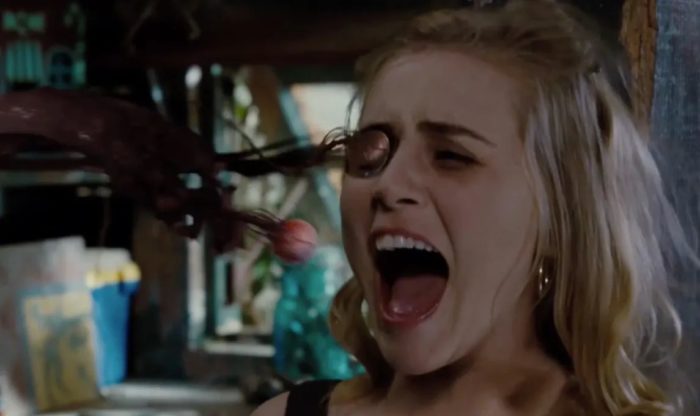When you think of Sam Raimi, what comes to mind? For most of us, the answer is probably demons, splatstick laughs, and Bruce Campbell. Rami is known mainly for his fun horror comedies like the Evil Dead trilogy and its fantastic TV continuation Ash vs Evil Dead, but if we look beneath the surface, we’ll find that there’s actually more to his work than just gory laughs. Take Drag Me to Hell, for example. While we can easily view it as nothing more than a fun romp with demons, it actually uses its horror storyline to convey an important message about a real problem in our society today.
Drag Me to Hell is about a loan officer named Christine who’s cursed by a Gypsy woman after she refuses to grant the woman an extension on her mortgage, and the demon who carries out the curse essentially does the same thing to her that she did to the Gypsy. The parallel is a bit subtle and unexpected, so you can easily miss it if you’re not looking for it. But once you see it, the connection becomes clear as day, and the message of the film just about smacks you upside the head.
Christine and Mrs. Ganush

After a couple of introductory scenes, Drag Me to Hell begins in earnest when Christine asks her boss Mr. Jacks about the vacant assistant manager position. He’s looking for someone to fill the role, and he says that his decision will come down to either Christine or her coworker Stu. Then, as if to subtly nudge her to do better, he praises Stu for being willing to “make the tough decisions,” so it looks like she might actually lose out on the promotion.
Soon afterwards, an elderly Gypsy woman named Mrs. Ganush comes into the bank asking for a third extension on her mortgage payment, and it’s up to Christine to decide what to do. Mrs. Ganush explains that she made every payment before she began to have some medical problems, so she just needs a bit more time to gather up enough money to start paying again.
Christine initially seems sympathetic, so she goes to her boss and asks what they can do for the woman. However, rather than offer a way to help, Mr. Jacks points out that Mrs. Ganush has already been granted two extensions, and he explains that the bank will make a lot of money on this type of foreclosure. It looks like he wants to reject her request, but Christine protests that they’d have to kick the poor woman out of her house. In response, Mr. Jacks just tells her, “It’s a tough decision. Your call,” clearly harking back to his praise of Stu a few moments earlier.

Then, Christine looks around the office, and she sees two things that help her make that tough decision. First, she sees the empty assistant manager’s chair, and then she sees Stu talking to some clients. She realizes that her promotion might depend on how she handles this situation, so she goes back to her desk and denies Mrs. Ganush’s request. The woman begs her to reconsider, but Christine refuses to budge. She sticks to her decision, and when Mrs. Ganush tries to attack her, she calls security.
With this sequence, Drag Me to Hell lays the foundation for its entire story. Christine didn’t have to deny Mrs. Ganush’s request. She could’ve helped her if she wanted to, but she chose to ignore and exacerbate the poor woman’s suffering instead. She chose to look good to her boss and make her bank a lot of money, so she essentially kicked Mrs. Ganush to the curb just so she could move up the corporate ladder.
Sure, in a certain sense, Christine was well within her rights to deny the woman’s request for a third extension, but that doesn’t mean it was the right thing to do. Even though she didn’t break any of the bank’s rules, she did violate a higher principle: human dignity. People are infinitely more important than arbitrary rules like the ones that govern mortgage payments, so human dignity demands that we help them whenever they’re in need, even if “the rules” don’t.
And by violating that principle, by choosing her advancement up the corporate ladder over the needs of another human being, Christine did something truly despicable. In fact, Drag Me to Hell tells us that this act was worse than despicable. It was actually demonic.
The Lamia and Christine

That may sound a bit extreme, but as Drag Me to Hell progresses, it literally becomes the message of the movie. As payback for her harsh treatment, Mrs. Ganush places a curse on Christine and puts her in the crosshairs of the Lamia, a powerful demon with a very specific M.O. This demon torments its victims in classic haunted house fashion for three days, and at the end of those three days, it comes for their souls, dragging them to hell for an eternity of fiery torment.
The curse takes effect pretty quickly, and Christine soon becomes desperate to find a way out. She sacrifices her pet kitten to try to appease the Lamia, and when that doesn’t work, she attends a séance to persuade it not to take her. Two psychics are present at this ritual, and when the demon appears, one of them asks what it wants. It says it wants Christine’s soul, and in response, the psychic tries to dissuade it from carrying out its plan. But of course that doesn’t work. The Lamia just laughs and reiterates its desire to drag the poor woman to hell, and at that point, it becomes clear that the demon is doing the exact same thing to Christine that she did to Mrs. Ganush.
Mrs. Ganush asked Christine to have pity on her and give her an extension on her mortgage, and Christine could’ve granted the woman’s request if she wanted to. As Mr. Jacks said, it was her call. She was just selfish and heartless, so she ignored Mrs. Ganush’s plea. She wanted to look good to her boss and advance her career, so she let the rules of foreclosure take their normal course.
Similarly, Christine asked the Lamia to have pity on her and spare her soul, and the Lamia could’ve done so if it wanted to. It wasn’t bound by Mrs. Ganush’s curse, so it didn’t have to take Christine’s soul. But it too was selfish and heartless. It wanted her soul for its own evil pleasure, so it ignored her plea and let the rules of the curse play out like they normally do.

That parallel is pretty clear, but if there’s still any doubt left, Drag Me to Hell squashes it in the final scene. After Christine realizes she can’t stop the Lamia, she tries to pass the curse over to Mrs. Ganush in the afterlife, and when she thinks she’s done it, she admits to her boyfriend Clay that she treated the woman unfairly. She admits that she could’ve granted her an extension, so she was wrong not to.
And why does she do that? Why does she finally come to terms with her selfishness? She doesn’t say, but it’s no coincidence that it happens right after she went through hell with the Lamia. She must’ve seen the parallel we’ve been exploring throughout this article. She must’ve realized that by refusing to help Mrs. Ganush, she had acted like the Lamia, so there’s no question that her choice to deny the woman’s request for an extension was wrong. In fact, it was more than wrong. It was demonic, and therein lies the message of Drag Me to Hell.
The film reminds us that we have an obligation to help those in need, so following “the rules,” whether they’re the rules of our workplace or anywhere else, doesn’t excuse heartless behavior like Christine’s. Human dignity trumps everything else, so to turn a blind eye to human suffering is always wrong. Period. And if we really want to take the message of Drag Me to Hell seriously, it’s a wrong of the highest order. It’s nothing less than demonic.




Sure. When money is deleted and people are productive despite no ability to control what they receive in return for their productivity, then we can do nice things if we work for banks.
AI/automation may actually force this reality on us but I don’t think the socialist-leaning among us are going to get the future they wanted exactly. It’s gonna be a bit more dystopian.